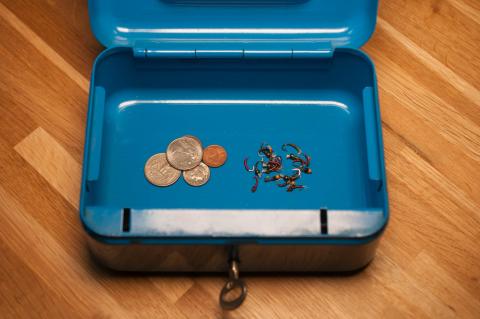Thanks martin i've got it now i need to use a combination of inner and outer tubing thank you very much for your help.By the way what pattern or style of fly are suitable for the scierra bullet tubes ? Again thanks for your help.
Recent comments
Ian,
Using a 275 grain (almost 18 grams) head on a 4 wt. seems a quite heavy to me - even considering that the Skagit technique calls for heavy, short heads. When casting overhead we typically use a 14-15 grams (225 grains or so) head on a 5 or 6 wt. rod and a head for a 4 wt. would be more like 12-13 grams or around 200 grains. I would think that lifting and controlling the heavy head in a current would be difficult.
Regarding your questions:
1) Yes, the weight and surface of the shooting line is critical to the length and quality of the cast. A heavy line with too much friction can essentially prevent any shooting, especially at lower line speeds as you have when Skagit or underhand casting. On the other hand you might gain distance and shoot longer with a smooth and light line (like mono), but will have no friction to help turn over the head and present the fly.
My personal preference lies somewhere in between. I use hollow, braided shooting lines when possible.
2) The above pretty much answers this. Yes, the hollow, braided lines combine weight, friction and handling in the optimal way in my eyes. Unfortunately the good ones are few and far between. I have tried almost all of them, and my preference is a line discontinued by the manufacturer. I have tried the Airflo braided lines - they have had several different types - and while they shoot and handle well, they sink and have a tendency to kink and knot. Careful stretching and coating with a floatant can help, but never makes them perfect. Still, my guess is that a braided or a thin, coated line would be a good choice for your light setup - unless you can cope with the idiosyncrasies of mono, which can be had in almost any thickness you want. I personally dislike the lack of friction, but it might work for you as it does for a lot of people.
There's basically only one way to go, and that's trying as many as you can. Luckily a lot of them are fairly inexpensive, and you can buy a bunch a try them out until you find the one that suits you best.
You have probably seen FlyFish USA's selection, which is quite large and covers most types.
Martin
- Log in to post comments
Noel,
Sometimes people simply let the hook trail the tube or use a piece of plastic tube or a pearl to create some distance. Some of the bottle tubes even allow a sleeve to go inside.
Oftentimes the bottle tubes are meant to be mounted on plastic tubes, which can then accept a sleeve.
Here are some examples:
Hooks on tubes
Weight mounted on tubes in different ways
Martin
Martin
The scierra bullets i have won't accept silicone tubing thats why im stumped. Maybe they're designed to just let the hook hang freely? Thanks anyway
Hi Martin, This spring, when the water softens up I am going to be trying to advance some Scandi and Skagit techniques for trout (Colorado/Wyoming). I have been practicing these techniques with a Redington Prospector (10'9" 4wt) using single hand lines such as SA Steelhead WF7F (also 6 & 8 versions), and distance is a bit of a fight. I'm looking to put a 250-275 grain Scandi setup on that rod and will need a running line. I have an SA .30 Ultra 4 level line that is probably a bit too heavy.
I also want develop a Scandi Head for a 5wt 9' rods to use in situations when line control is not a priority, I often like to swing soft hackles or streamers at the end of a day when my eyes are tired and the light's fading. And of course, the fish go nuts on it with enough regularity to keep it interesting. I may cut and splice a few frankenlines along the way.
Question 1: My impression is that shooting line weight and friction can have a much bigger impact on distance using ultra light spey techniques (and using those casts with single hand rods.). Comments?
Question 2: Hollow braid seems like a very attractive option. Have you tried Airflo's miracle braid? Is there another braid that has arrived on the market since your fine article that you would recommend?
- Log in to post comments
NZ ENVIRONMENTAL UPDATE
As a follow-up to my previous comments, the fishing is still good in NZ, but our water resources are under huge pressure from big farming interests, which the current government seems eager to appease.
On top of didymo, there are two big problems. First one is pollution caused by dairy farms. The number of dairy cows on the land exceeds 6.5 million and increases annually. Waste from these animals and the fertiliser nitrates applied to pastures is not properly managed. (Google "Dirty dairying in New Zealand" and see what comes up).
Secondly, irrigation schemes funded by taxpayer handouts promote more of this damage, because the government is keen to see farm production doubled. The tourist industry and the rivers will be sacrificed in the process.
Finally, regarding the charges by fishing guides referred to above, the average fee is now about $NZ750-800 daily for two anglers. I agree a guide is essential for visitors with little time. Don't forget we have public waters, so you are likely to meet others on the river.
So don't just visit NZ and go home - help us preserve the fishing for future generations. A good start would be to fish North Island first (didymo free) then go to South Island.
Fly Fishing New Zealand website has good advice that is up-to-date.
- Log in to post comments
Dennis,
Paul Morgan has it in his shop Coch-y-Bonddu Books, but it's pretty expensive. Many other sellers have it listed in that price range. But there's also a copy on Amazon, which sells at close to the cover price. Still expensive, but not quite so much.
Martin
- Log in to post comments
Please let me know how to order "A celebration of Salmon Rivers" .Thanks in advance for answering.Denis MADIEU - France.
- Log in to post comments
does anyone know how to attach hooks to these scierra river bullets ?
I like this
Outstanding patterns there gentlemen, the craftsmanship is superb. My hat's off to you.
- Log in to post comments
Splendid work here guys! I couldn't pass these by without showing my appreciation for these little beauties!
- Log in to post comments
Yes I like bringing bugs home too. I put a napkin in the bottom of a tupperware food container, which helps some with wet adult bugs and puddles of water.
[img:8d41abfd82]http://montana-riverboats.com/Uploads/Callibaetis-two.jpg[/img:8d41abfd…]
- Log in to post comments
Jim,
You can use one pearl in stead of two, but I usually prefer two because I can keep the copper wire free of the body and have it grab the eye and the shank, and it gives a better control because the flies can't rotate. But one pearl and a single holding point can work too.
Martin
- Log in to post comments
Martin-- I have 16 miniature full dress feather wing Atlantic Salamon flys--is there any reason why I could not mount them in my shadow box by threading the cooper wire through a clear pearl or clear tube then around the middle of the hook shank?
thx Jim Hagar
ps RU related to Poul Jorgensen?
- Log in to post comments
Great picture of the caddisI usually carry a small round plastic container with me when I fish. When I get home I'll study it under a magnifying class. This lead to a very successful midge/black fly/gnat/trico pattern which has caught me many fish over the last 12 years or so here in the Northeast. SE/NE PA, Catskills, Adirondacks, Vermont and the Grand and Upper Credit Rivers in southern Ontario. Tying without a specimen or basing a pattern on a book as its problems. There is a Little Black Caddis hatch on a local creek. I had one of the Orvis stream insects books and it said it's tied on a size 16 hook. So that's what I did. Took the flies out to the stream and watched the trout ignore them. Got a bit frustrated and took a break laid my rod down with the fly on a boulder and a couple of the actual caddis landed next to the fly and I was shown the error of my ways. Caught a couple took them home measured them they were about 7 mm long including the wings. The body was 3 mm long. Measured a standard size 16 dry fly hook. The length of the shank was 7 mm. So the caddis was a size 16 it just shouldn't have been tied on a size 16 hook. Another thing that I learned was the caddis wasn't all black. The body was a dark battleship gray.
I'm also a big fan of having an example of a new fly I want to tie in front of me. Sometimes I can wheedle one from the tyer, sometimes they give me one, sometimes I have to buy one. I definitely want a picture if I'm tying a bait fish pattern.
- Log in to post comments
[b:2517abde0d]Newborn Ver.2014.
[/b:2517abde0d]
Imitation of small fish hatched from egg, tail forward.
My idea for this fly is from 2012, but now, I show its new version.
[img:2517abde0d]https://lh6.googleusercontent.com/-lEhdOJL5g48/VJIEqXAqulI/AAAAAAAAH3g/…]
[img:2517abde0d]https://lh5.googleusercontent.com/-sD3lHfA226w/VJIEsoo0ikI/AAAAAAAAH3o/…]
All the best.
Miro
- Log in to post comments
Always exciting to come upon a new (to me) technique that makes my tying easier/more streamlined.
This one is fabulously smooth and simple. Why didn't I think of it years ago?? Thx ever so, Hans.
- Log in to post comments
Jim,
I have no idea whether a salmon turns its eyes down as a reaction to light. I have never heard about that before and never seen it happen, but you might be right.
Regarding the life or death of the fish that Nils is holding, I'm almost 100% sure they are all alive and were returned to live on. Nils is an avid C&R fisherman, and even though he does keep a bright fish to eat now and then, basically all his salmon are released again.
Martin
- Log in to post comments
I believe all of the salmon photographed are dead. A live salmon's eyes will be down turned in response to unaccustomed light. Am I right?
- Log in to post comments
Great article, Martin. And yes, float tubes are lot of fun everywhere. Good fishing! Juan
- Log in to post comments

